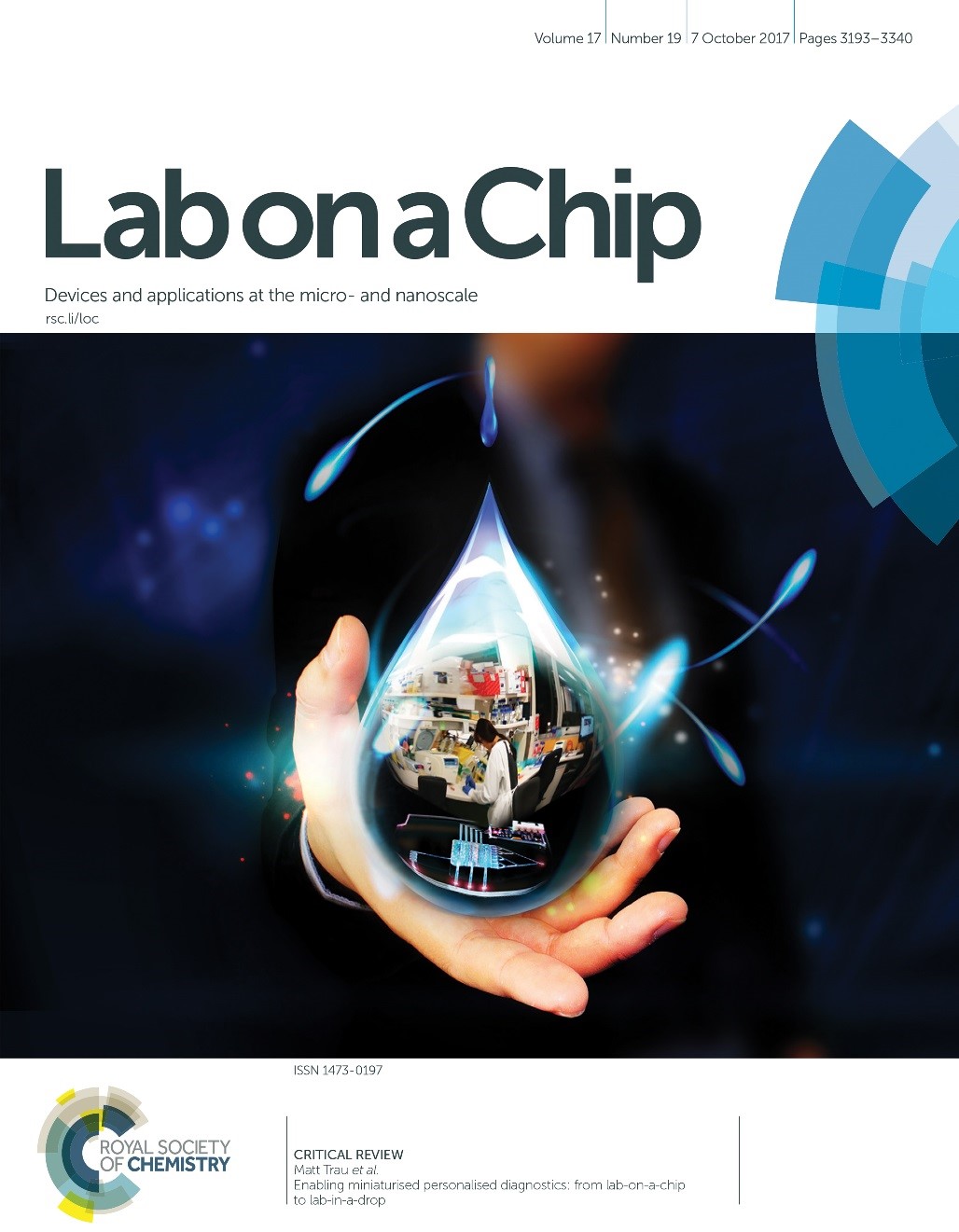
AIBN PhD student Kevin Koo and his colleagues in the Trau group have authored a recent front cover article in the journal Lab on a Chip. The review highlights the Trau group’s research advancements in the development of miniaturised lab-in-a-drop biosensors, and the role AIBN research is playing in moving the field forward. Following a prior relevant study which was featured on the cover of the journal Small, this latest article marks Kevin’s second first-authored cover publication in the past few months that has been recognized by esteemed journals in the field of miniaturised diagnostics.
Accurate early diagnosis of many diseases provides an opportunity for early therapeutic intervention. Moreover, the biology of certain diseases (such as cancer), can vary significantly from patient to patient. In these cases, a more individualised diagnosis could make a big difference in personalised treatment strategies. Ideally, such rapid, personalised diagnosis would take place at the point of care, without delays involved in sending samples away for analysis.
In recent years, lab-on-a-chip (LOC) devices have become a useful personalised diagnostic system that can be used at the point of care. They tend to use very small amounts of sample and can have quick turn-around-times. However, LOCs have a number of limitations. These tiny chips usually involve highly complex precision fabrication procedures and are costly to fabricate. Thus, the majority of LOC systems have faced difficulties in progressing to real-world products for practical applications since their emergence decades ago.
For this reason, Trau group researchers are motivated to use nanotechnology for fabrication-free disease biomarker detection within a fluidic droplet.
“A feasible solution to current LOC limitations is an alternative miniaturised solution-based biosensing system,” says Koo. This kind of system, he adds, “facilitates rapid and sensitive miniaturised analysis of disease biomarkers from a single drop of sample.”
In this review article, Koo explains the latest advances in these miniaturised solution-based disease detection technologies, also collectively termed as the “lab-in-a-drop” system, and how they can be extremely useful for the detection of disease nucleic acid biomarkers. Nucleic acids like DNA and RNA play important roles in the initiation and progression of diseases such as cancers, and can serve as useful biomarkers for early disease detection.
The lab-in-a-drop technology is already proving effective in the detection of prostate cancer RNA biomarkers. The current clinical biomarker-based prostate cancer test is unfortunately not cancer-specific and can lead to unreliable diagnoses. Because prostate cancer cells are present in patient urine samples, Koo and his colleagues has been researching on point-of-care nanodiagostic systems for detecting novel prostate cancer-specific urinary RNA biomarkers. By leveraging lab-in-a-drop systems, the detection of these urinary biomarkers for personalised cancer could be achieved without lengthy laboratory-based bioassays.
“All biomarker detection steps are integrated and miniaturised into one small volume reaction,” said Koo. “It has been shown to possess detection sensitivity down to single-cell level.”
Among the different lab-in-a-drop technologies is a multiplex system which uses gold plasmonic nanoparticles to detect the presence of several disease biomarkers simultaneously. In this approach, the various nucleic acid biomarkers are purified from biological samples, amplified, and tagged with respective target-specific gold nanoparticle labels. When excited by laser, each gold nanoparticle label then generates a strong unique spectroscopic signal to indicate detected biomarker levels.
Lab-in-a-drop systems can also be used for naked-eye detection of a wide range of diseases. This approach uses magnetic particles which are usually dispersed in solution. When a sample containing the disease biomarker is added to a fluidic droplet of magnetic particle, the particles are induced to clump together and the solution changes colour. This system could be particularly useful for quick and inexpensive detection of diseases, such as tuberculosis, in remote or impoverished areas of the world. It may also enable easy detection of plant pathogens in agricultural settings.
The range of potential applications for lab-in-a-drop biosensors is huge, says Koo.
“These approaches are pretty versatile, and easily tailored for the detection or monitoring of different kinds of diseases with DNA or RNA biomarkers.”



